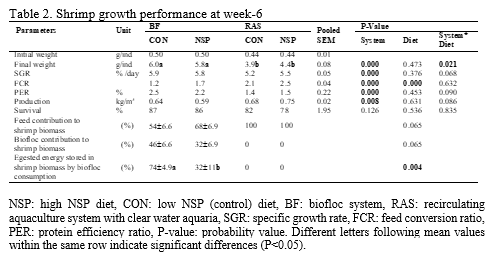DIETARY SUPPLEMENTATION OF NON-STARCH POLYSACCHARIDES AFFECTS DIGESTIBILITY AND GROWTH OF PACIFIC WHITE SHRIMP Litopenaeus vannamei IN BIOFLOC AND RAS SYSTEMS
Introduction
Energy transfer in aquaculture systems depends on the interactions between the biota contributing to the food web , e.g. the culture species, algae, bacteria, and fungi. The interacting biota are part of an ecological trophic cascade exchanging energy and nutrients . The efficiency of energy transfer through the food web can be influenced by the diet and the resulting fecal composition . In Pacific white shrimp culture, when starch dominates the dietary carbo n input, the majority will leave the system as CO2, limiting access for further carbon utilization in the system . S upplementing non-starch polysaccharide (NSP) in the diet results in more carbon retained in the shrimp feces due to its low digestibility in shrimp . However, the h eterotrophic bacteria in the rearing tank can utilize this carbon and transfer part of its energy to the food web . Together with algae, heterotrophic bacteria are at the base of the food web. In a b iofloc system both biotas are present . This research compared the effect of a high and a low NSP diets on biofloc performance and shrimp production. Furthermore, the study also estimated the contribution of biofloc to shrimp growth reared in biofloc systems by estimating the growth in a zero biofloc system - recirculating aquaculture system (RAS).
Materials and methods
This experiment compared two diets differing in the NSP level: high (NSP) and low (CON). The first mentioned diet contains wheat bran as the NSP source . Two experiments, a growth and a digestibility experiment, were carried out. In the growth experiment , two culture systems were compared (Table 1) : biofloc and RAS (with clear water rearing tanks) system, for 6 weeks. The digestibility experiment lasted for 5 weeks and was done only in RAS only . The biofloc treatments were performed in circular 1000-L fiber mesocosm tank in triplicates . The clear water rearing tanks were 120-L aquaria all part of the same RAS , with 4 replicates per treatment. The stocking densities were 100 ind/tank in biofloc tanks , 30-25 ind/aquaria in RAS, both for the growth and digestibility experiment. The shrimp were fed iso proteinic, once daily.
Results
NSP: high NSP diet, CON: low NSP (control) diet, BF: biofloc system, RAS: recirculating aquaculture system with clear water aquaria, SGR: specific growth rate, FCR: feed conversion ratio, PER: protein efficiency ratio, P-value: probability value . Different letters following mean values within the same row indicate significant differences (P<0.05).
The results showed that NSP diet increased the carbon to nitrogen (CN) ratio of the shrimp feces from 11.8 in CON treatment to 20.5, which later stimulated more biofloc formation (P<0.05). The algae concentration in the biofloc at week-6 was higher when shrimp was fed with NSP diet (P<0.05). The NSP diet had a lower apparent digestibility coefficient (ADC) of dry matter, protein, energy, carbohydrate, and minerals (P<0.05). The experimental d iet did not show any effect on the shrimp production (P>0.05), but the system did (P<0.05), due to the higher stocking density in tanks (Table 2 ). Feed conversion ratio was higher with NSP diet (P<0.05). Biofloc presence as an additional natural food that contributed to an increase of the shrimp biomass by 32% in NSP and 46 % in CON diet in BF tanks . The fraction of egested energy stored in shrimp biomass based on biofloc consumption was higher BF tanks fed the CON diet than in BF tanks fed the NSP diet (P<0.05). The NSP diet resulted in a 24% higher carbohydrate content in shrimp biomass at harvest (P<0.05).Future research should focus on the effect of NSP type in the diet on shrimp performance in biofloc tanks.
Conclusions
- Increasing the NSP content in the diet increases the C:N ratio in the feces.
- Although the NSP diet is less digestible than the CON diet, when f ed isoproteinic, the final weight reached was similar , in either RAS or BF system.
- In BF tanks fed the NSP diet, more biofloc was present than in BF tanks fed the CON diet , but shrimp did not realize more growth based on biofloc in NSP fed BF tanks than in CON fed BF tanks.

